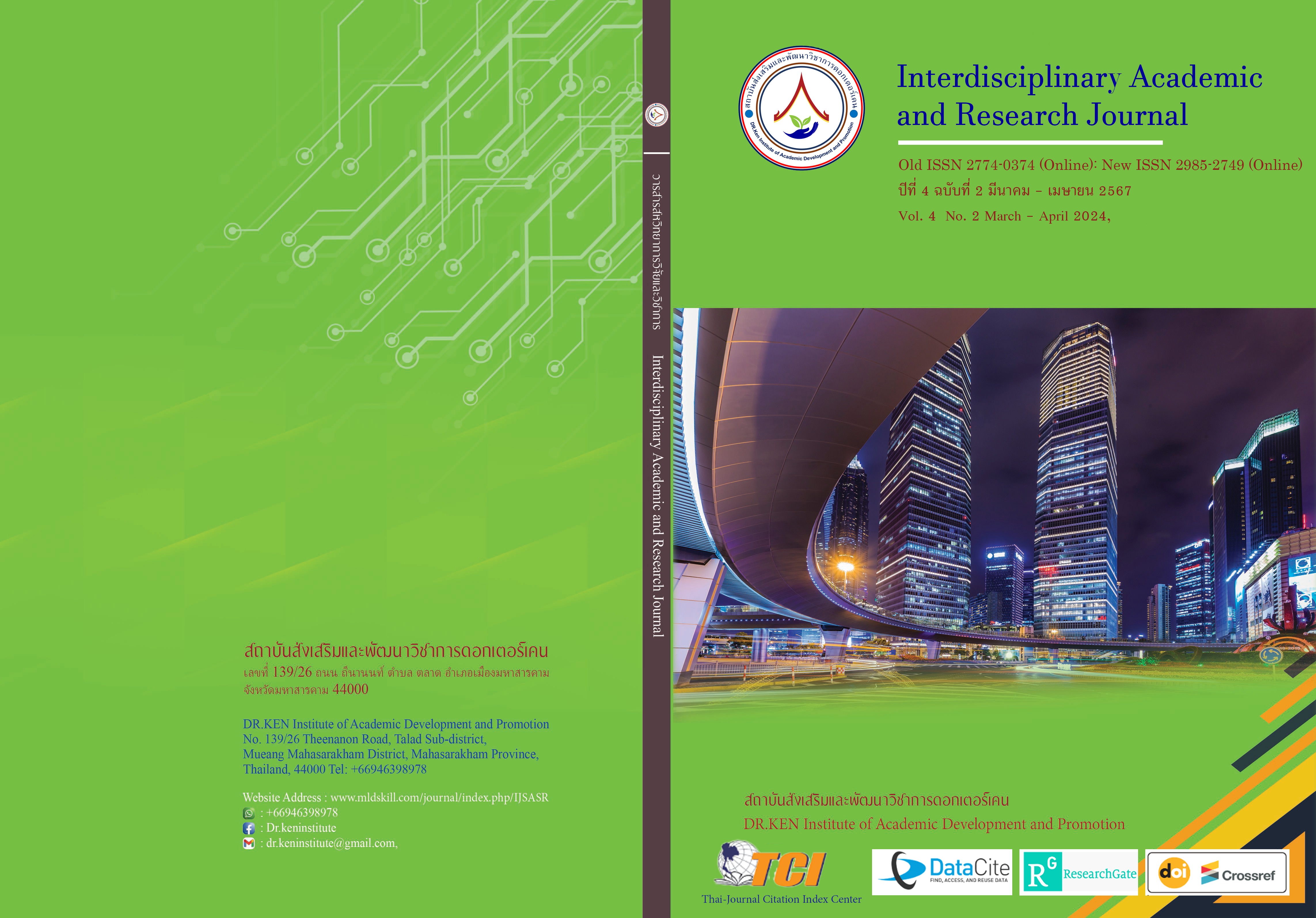A Study on the Prevalence of Peer Bullying Among Preschool Children: A Case Study of Wat Angthong Kindergarten School
DOI:
https://doi.org/10.60027/iarj.2024.276121Keywords:
Bullying; , Prevalence; , Rhythmic Pacing StudentAbstract
Background and Aims: Bullying problems can occur at all ages and tend to become more severe with age. In early childhood, bullying can also occur. Few studies show that early childhood children can bully each other. This research study will make parents, teachers, and other stakeholders aware and give importance to solving this problem in the future. This research aims to investigate the prevalence of peer bullying among preschool children at Anuban Wat Angthong School.
Methodology: It employs a case study approach within the mentioned school, gathering data from 547 students in kindergarten levels 1 to 3 during the academic year 2023. Classroom teachers serve as observers and assessors of student behaviors, with statistical analysis used to interpret the observed behaviors in terms of frequency and percentages.
Results: The study found that the majority of preschool children at Anuban Wat Angthong School did not exhibit bullying behaviors in all three forms: physical, verbal, and social. Specifically, (1) physical bullying behaviors were observed in 68.20% to 94.50% of students across 10 sub-behaviors, (2) verbal bullying behaviors were observed in 88.10% to 95.60% of students across 8 sub-behaviors, and (3) social bullying behaviors were observed in 88.80% to 95.60% of students across 4 sub-behaviors.
Conclusion: According to the study, while the majority of preschoolers at Anuban Wat Angthong School did not participate in bullying behaviors, a sizeable percentage did engage in physical, verbal, and social forms of bullying. Prevalence rates for these sub-behaviors ranged from 68.20% to 95.60%.
References
กระทรวงศึกษาธิการ. (2559).นโยบายและยุทธศาสตร์การพัฒนาเด็กปฐมวัย (0-5 ปี) ระยะยาว พ.ศ.2550-2559. กรุงเทพฯ: โรงพิมพ์คุรุสภา.
กระทรวงศึกษาธิการ. (2560). คู่มือหลักสูตรการศึกษาปฐมวัย พุทธศักราช 2560. กรุงเทพฯ: โรงพิมพ์คุรุสภา.
กระทรวงศึกษาธิการ. (2560). หลักสูตรการศึกษาปฐมวัย พุทธศักราช 2560. กรุงเทพฯ: โรงพิมพ์คุรุสภา.
เกษตรชัย และหีม. (2554). พฤติกรรมการรังแกของนักเรียน. สงขลา: หน่วยโสตทัศนศึกษา คณะวิทยาศาสตร์ มหาวิทยาลัยสงขลานครินทร์.
ชิดชัย ไขไพรวัณ.(2560). พฤติกรรมการรังอกผู้อื่นของนักเรียนมัธยมปลาย เขตราชเทวี กรุงเทพมหานคร. สารนิพนธ์สาธารณสุขศาสตรมหาบัณฑิต. มหาวิทยาลัยมหิดล
เฌณิกา บุณยธนวัฒน์. (2559). บทความวิจัย เรื่องละครโทรทัศน์ที่สะท้อนปัญหาการรังแกใน โรงเรียนประเทศญี่ปุ่นเรื่อง 35-sai no Koukousei. ปริญญานิพนธ์อักษรศาสตร์บัณฑิต. มหาวิทยาลัยศิลปากร.
ธิดารัตน์ ปุรณะชัยคีรี, สิรินัดดา ปัญญาภาส, & ฐิตวี แก้วพรสวรรค์. (2558). กลยุทธ์ในการแก้ปัญหาการถูกรังแกของ เด็กนักเรียนระดับชั้นประถมศึกษาตอนปลาย. วารสารสมาคมจิตแพทย์แห่งประเทศไทย, 60(4), 275- 286. https://psychiatry.or.th/JOURNAL/60-4/03%20Tidarat.pdf
ปวริศร์ กิจสุขจิต. (2559). ปัจจัยที่เป็นสาเหตุให้เกิดการรังแกกันในโรงเรียนมัธยมสตรี ใน กรุงเทพมหานคร ตามแนวทฤษฎีเรียนรู้ของโรนัลด์ แอล เอเคอร์. วารสารวิทยบริการ, 27(1), 72-80.
ปองกมล สุรัตน์. (2561). การรังแกผ่านโลกไซเบอร์ในมิติสังคมวัฒนธรรม : กรณีศึกษาเยาวชนไทย เจเนอเรชั่น Z. วิทยานิพนธ์ปรัชญาดุษฎีบัณฑิต สาขาวิชาการวิจัยพฤติกรรมศาสตร์ประยุกต์: มหาวิทยาลัยศรีนครินทรวิโรฒ.
พงษ์สุดา ป้องสีดา. (2564). ความชุกของการรังแกกันและปัจจัยด้านครอบครัวที่เกี่ยวข้องในนักเรียน ระดับชั้นประถมศึกษาตอนปลายและมัธยมศึกษา จังหวัดน่าน. เชียงรายเวชสาร, 13 (2), 102-119.
โรงเรียนอนุบาลวัดอ่างทอง. (2563). หลักสูตรสถานศึกษา การศึกษาปฐมวัย (ฉบับปรับปรุง). อ่างทอง: โรงเรียนอนุบาลวัดอ่างทอง ตำบลบางแก้ว อำเภอเมืองอ่างทอง.
วิณี ชิดเชิดวงศ์. (2537). การศึกษาเด็ก. กรุงเทพฯ: บูรพาศาสน์.
ศิริชัย กาญจนวสี, ดิเรก ศรีสุโข, ทวีวัฒน์ ปิตยานนนท์. (2559). การเลือกสถิติที่เหมาะสมสำหรับการวิจัย. พิมพ์ครั้งที่ 7. กรุงเทพฯ: โรงพิมพ์จุฬาลงกรณ์มหาวิทยาลัย.
ศุภรดา ชุมพาลี และทัศนา ทวีคูณ. (2562). พฤติกรรมรังแกกันของนักเรียนชั้นมัธยมศึกษาตอนต้น ของจังหวัดหนึ่งในภาคกลาง ประเทศไทย. วารสารการพยาบาลจิตเวชและสุขภาพจิต, 33 (3),128-148.
สถาบันสุขภาพจิตเด็กและวัยรุ่นราชคนรินทร์. (2561). คู่มือปฏิบัติสำหรับการดำเนินการการป้องกันและจัดการปัญหาการรังแกกันในโรงเรียน. พิมพ์ครั้งที่ 1. กรุงเทพมหานคร: บียอนด์ พับลิสชิ่ง.
สำนักงานศึกษาธิการจังหวัดอ่างทอง. (2564). รายงานการขับเคลื่อนปฐมวัยจังหวัดอ่างทอง. อ่างทอง: สำนักงานศึกษาธิการจังหวัดอ่างทอง.
Buss, A. H. (1961). The psychology of aggression. John Wiley & Sons, Inc.
Kirves, L. & Sajaniemi N. (2012). Bullying in early educational settings. Early Child Development and Care. 182(3-4), 383 – 400. Retrieved November 30, 2022, from https://www.tandfonline.com/doi/abs/10.1080/03004430.2011.646724
Storey K. and Slaby R. (2013). Eye on Bullying in Early Childhood. USA: Education Development Center.
Downloads
Published
How to Cite
Issue
Section
License
Copyright (c) 2024 Interdisciplinary Academic and Research Journal

This work is licensed under a Creative Commons Attribution-NonCommercial-NoDerivatives 4.0 International License.
Copyright on any article in the Interdisciplinary Academic and Research Journal is retained by the author(s) under the under the Creative Commons Attribution-NonCommercial-NoDerivatives 4.0 International License. Permission to use text, content, images, etc. of publication. Any user to read, download, copy, distribute, print, search, or link to the full texts of articles, crawl them for indexing, pass them as data to software, or use them for any other lawful purpose. But do not use it for commercial use or with the intent to benefit any business.
















.png)


